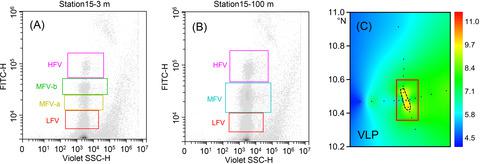当前位置:
X-MOL 学术
›
Microbiologyopen
›
论文详情
Our official English website, www.x-mol.net, welcomes your feedback! (Note: you will need to create a separate account there.)
Virioplankton distribution in the tropical western Pacific Ocean in the vicinity of a seamount.
MicrobiologyOpen ( IF 3.4 ) Pub Date : 2020-03-16 , DOI: 10.1002/mbo3.1031 Yanchu Zhao 1, 2, 3 , Yuan Zhao 1, 2, 4 , Shan Zheng 2, 4, 5 , Li Zhao 1, 2, 4 , Xuegang Li 1, 2, 4 , Wuchang Zhang 1, 2, 4 , Gérald Grégori 6 , Tian Xiao 1, 2, 4
MicrobiologyOpen ( IF 3.4 ) Pub Date : 2020-03-16 , DOI: 10.1002/mbo3.1031 Yanchu Zhao 1, 2, 3 , Yuan Zhao 1, 2, 4 , Shan Zheng 2, 4, 5 , Li Zhao 1, 2, 4 , Xuegang Li 1, 2, 4 , Wuchang Zhang 1, 2, 4 , Gérald Grégori 6 , Tian Xiao 1, 2, 4
Affiliation

|
The shallow Caroline Seamount is located in the tropical western Pacific Ocean. Its summit is 57 m below the surface and penetrates the euphotic zone. Therefore, it is ideal for the study of the influence of seamount on plankton distribution. Here, virioplankton abundance and distribution were investigated by flow cytometry (FCM) in the Caroline Seamount in August and September 2017. The total abundance of virus‐like particles (VLP) was in the range of 0.64 × 106–18.77 × 106 particles/ml and the average was 5.37 ± 3.75 × 106 particles/ml. Three to four distinct viral subclusters with similar side scatter but different green fluorescence intensities were identified. Above the deep chlorophyll maximum (DCM), two medium fluorescence virus (MFV) subclusters were discriminated. Between the DCM and the deeper layers, only one MFV subcluster was resolved. In general, low fluorescence viruses (LFV) comprised the most abundant subclusters. In the 75–150 m water column, however, the MFV abundance was higher than the LFV abundance. High fluorescence viruses (HFV) constituted the least abundant subcluster throughout the entire water column. Virioplankton abundance was significantly enhanced at the seamount stations. Environmental factors including water temperature and nitrate concentration were the most correlated with the variation in virioplankton abundance at the seamount stations. Interactions between shallow seamounts and local currents can support large virus standing stocks, causing a so‐called indirect “seamount effect” on the virioplankton.
中文翻译:

浮游生物分布在海山附近的热带西太平洋。
浅海的卡罗琳海山位于热带西太平洋。它的山顶在水面以下57 m处,并穿过富营养区。因此,对于研究海山对浮游生物分布的影响是理想的。在这里,2017年8月和2017年9月在卡罗琳海山通过流式细胞仪(FCM)研究了浮游动物的丰度和分布。病毒样颗粒(VLP)的总丰度范围为0.64×10 6 –18.77×10 6 颗粒/ ml,平均值为5.37±3.75×10 6 颗粒/毫升 确定了三到四个具有相似侧向散射但绿色荧光强度不同的不同病毒亚簇。在深部叶绿素最大值(DCM)以上,区分了两个中等荧光病毒(MFV)子类。在DCM和更深层之间,仅解析了一个MFV子集群。通常,低荧光病毒(LFV)包含最多的子簇。但是,在75–150 m的水柱中,MFV的丰度高于LFV的丰度。在整个水柱中,高荧光病毒(HFV)组成的子簇最少。海山站的浮游生物丰度显着提高。包括水温和硝酸盐浓度在内的环境因素与海山站浮游生物丰度的变化最相关。浅海山峰和当地洋流之间的相互作用可以支撑大型病毒常备种群,对浮游生物造成所谓的间接“海山效应”。
更新日期:2020-03-16
中文翻译:

浮游生物分布在海山附近的热带西太平洋。
浅海的卡罗琳海山位于热带西太平洋。它的山顶在水面以下57 m处,并穿过富营养区。因此,对于研究海山对浮游生物分布的影响是理想的。在这里,2017年8月和2017年9月在卡罗琳海山通过流式细胞仪(FCM)研究了浮游动物的丰度和分布。病毒样颗粒(VLP)的总丰度范围为0.64×10 6 –18.77×10 6 颗粒/ ml,平均值为5.37±3.75×10 6 颗粒/毫升 确定了三到四个具有相似侧向散射但绿色荧光强度不同的不同病毒亚簇。在深部叶绿素最大值(DCM)以上,区分了两个中等荧光病毒(MFV)子类。在DCM和更深层之间,仅解析了一个MFV子集群。通常,低荧光病毒(LFV)包含最多的子簇。但是,在75–150 m的水柱中,MFV的丰度高于LFV的丰度。在整个水柱中,高荧光病毒(HFV)组成的子簇最少。海山站的浮游生物丰度显着提高。包括水温和硝酸盐浓度在内的环境因素与海山站浮游生物丰度的变化最相关。浅海山峰和当地洋流之间的相互作用可以支撑大型病毒常备种群,对浮游生物造成所谓的间接“海山效应”。



























 京公网安备 11010802027423号
京公网安备 11010802027423号